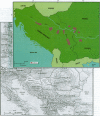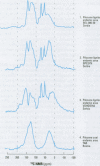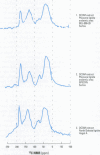Abstract
Balkan endemic nephropathy (BEN) has attracted increasing attention as a possible environmental disease, and a significant amount of research from complementary scientific fields has been dedicated to its etiology. There are two actual competing theories attempting to explain the cause of this kidney disease: 1) the mycotoxin hypothesis, which considers that BEN is produced by ochratoxin A ingested intermittently in small amounts by the individuals in the endemic regions, and 2) the Pliocene lignite hypothesis, which proposes that the disease is caused by long-term exposure to polycyclic aromatic hydrocarbons and other toxic organic compounds leaching into the well drinking water from low rank coals underlying or proximal to the endemic settlements. We outline the current developments and future prospects in the study of BEN and differentiate possible factors and cofactors in disease etiology.
Full text
PDF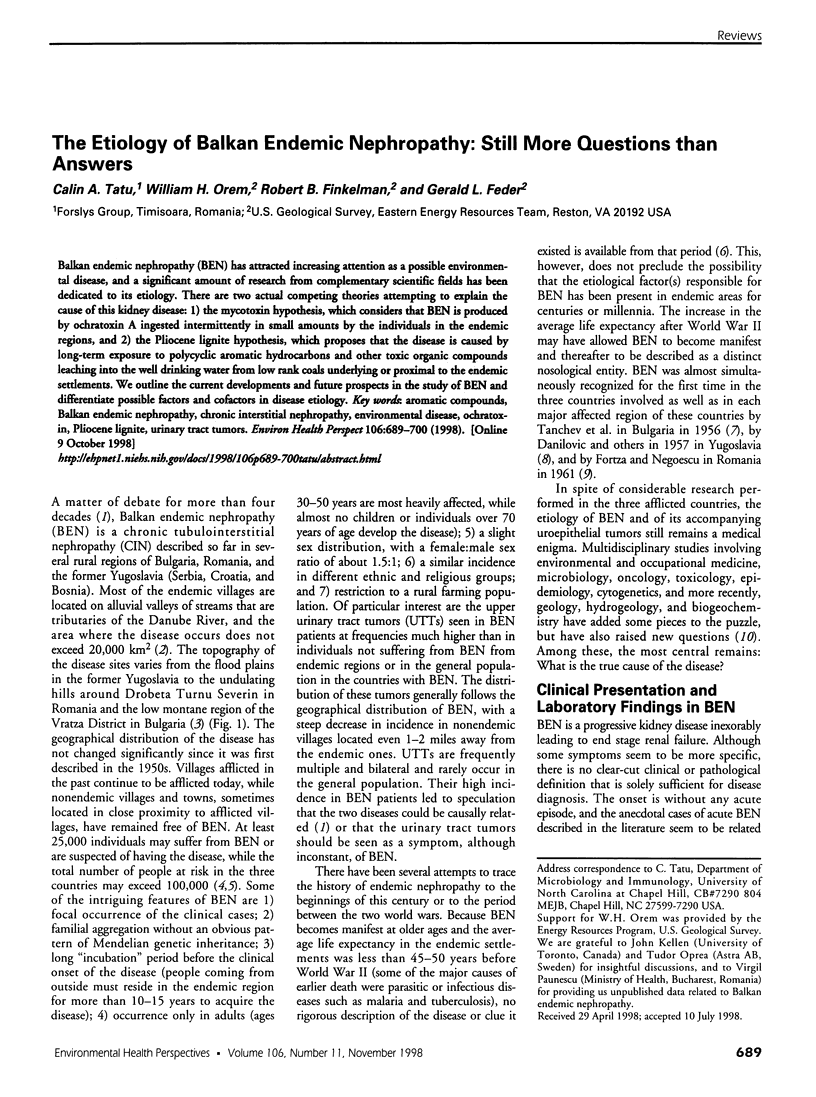
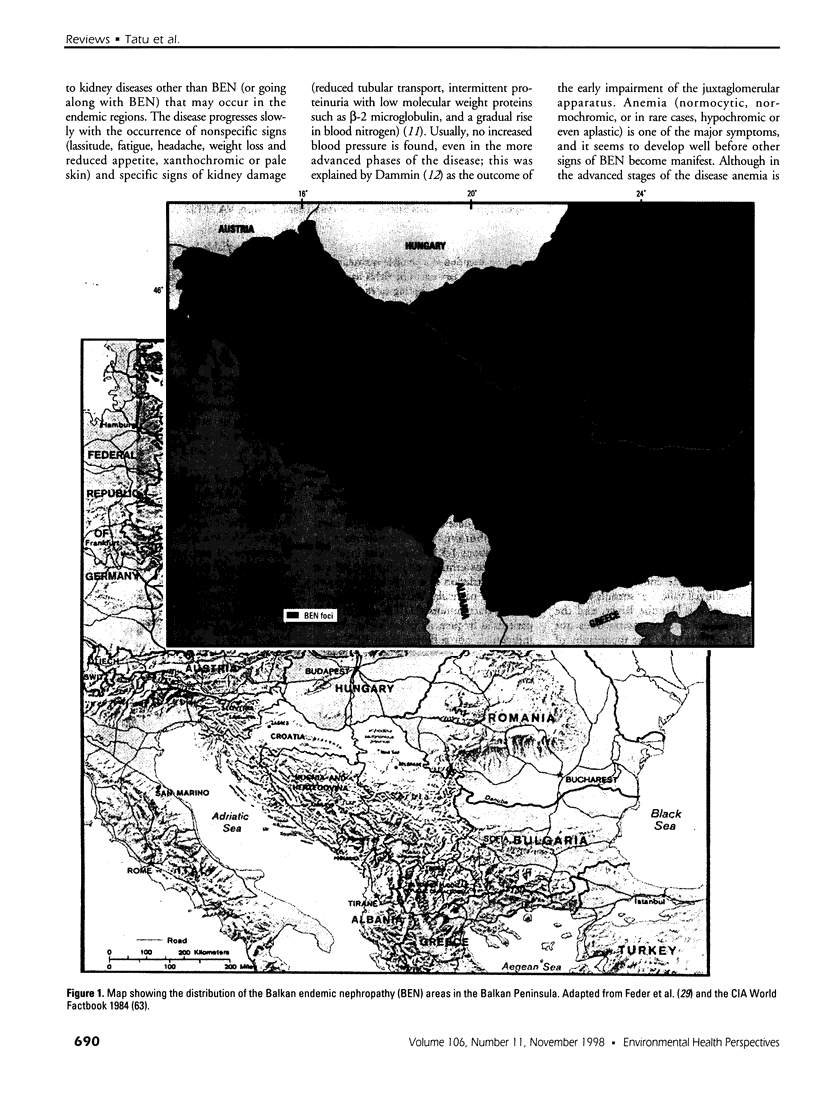
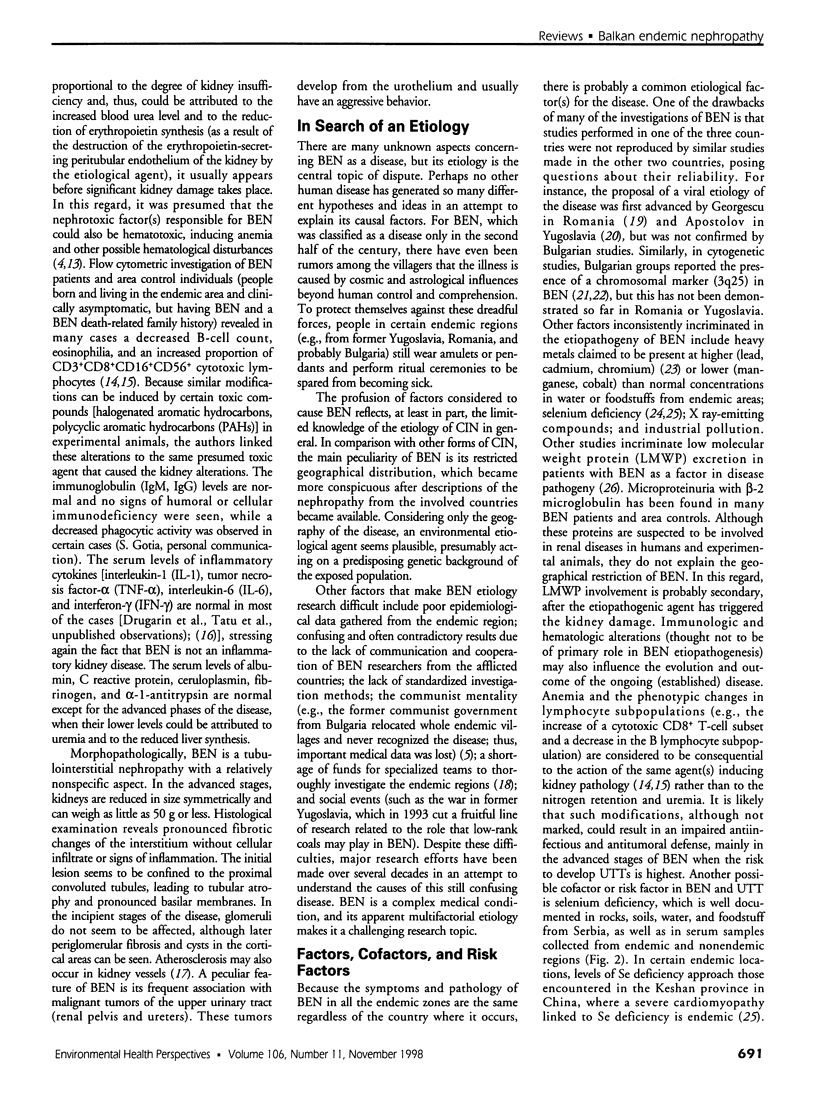
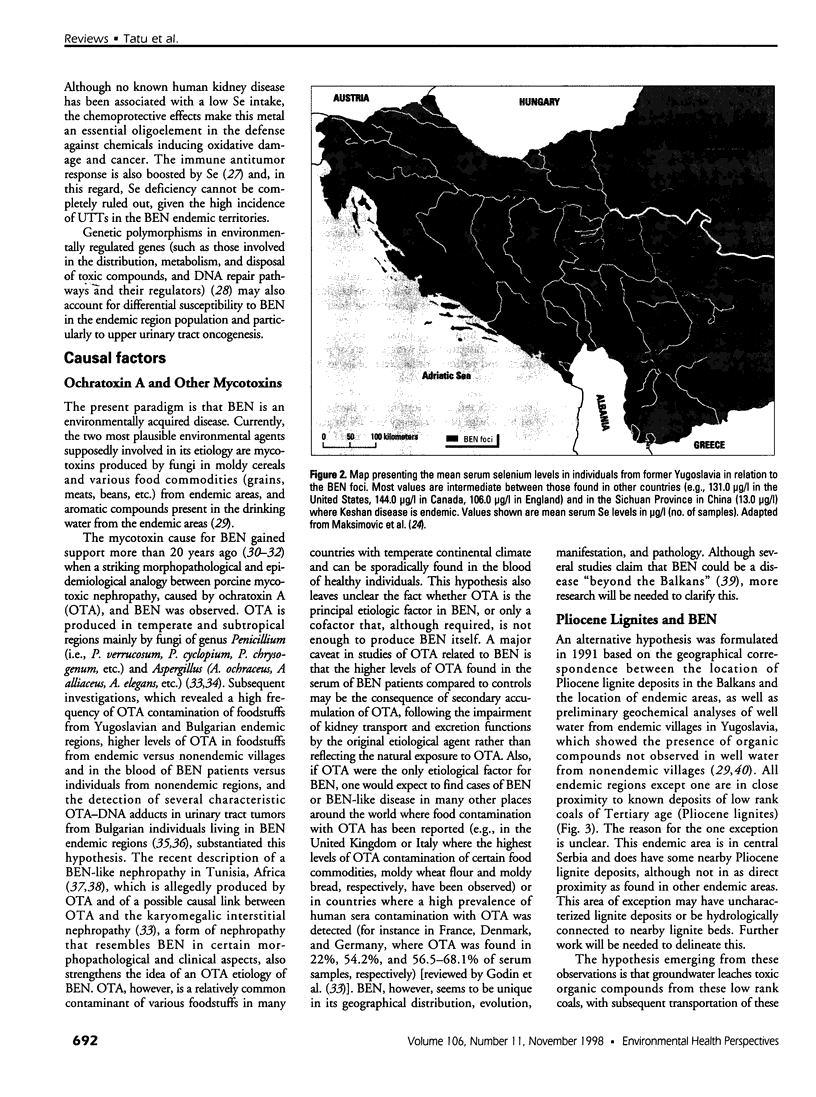
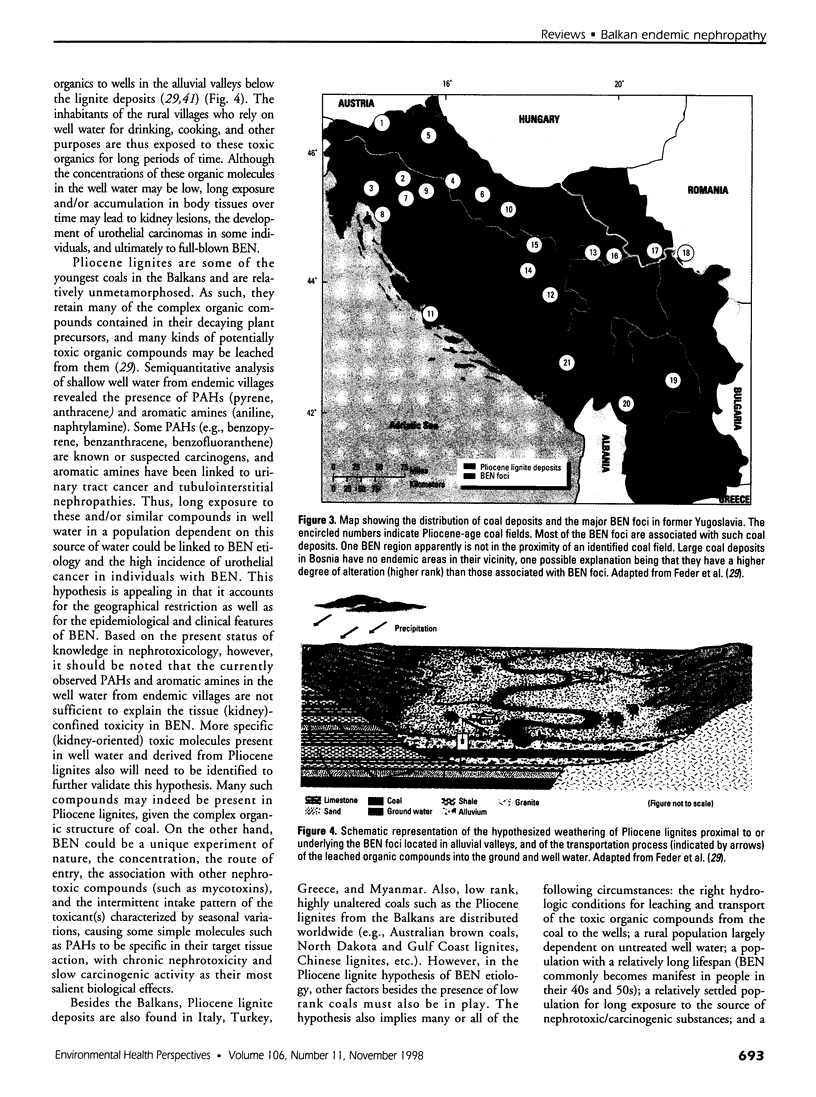
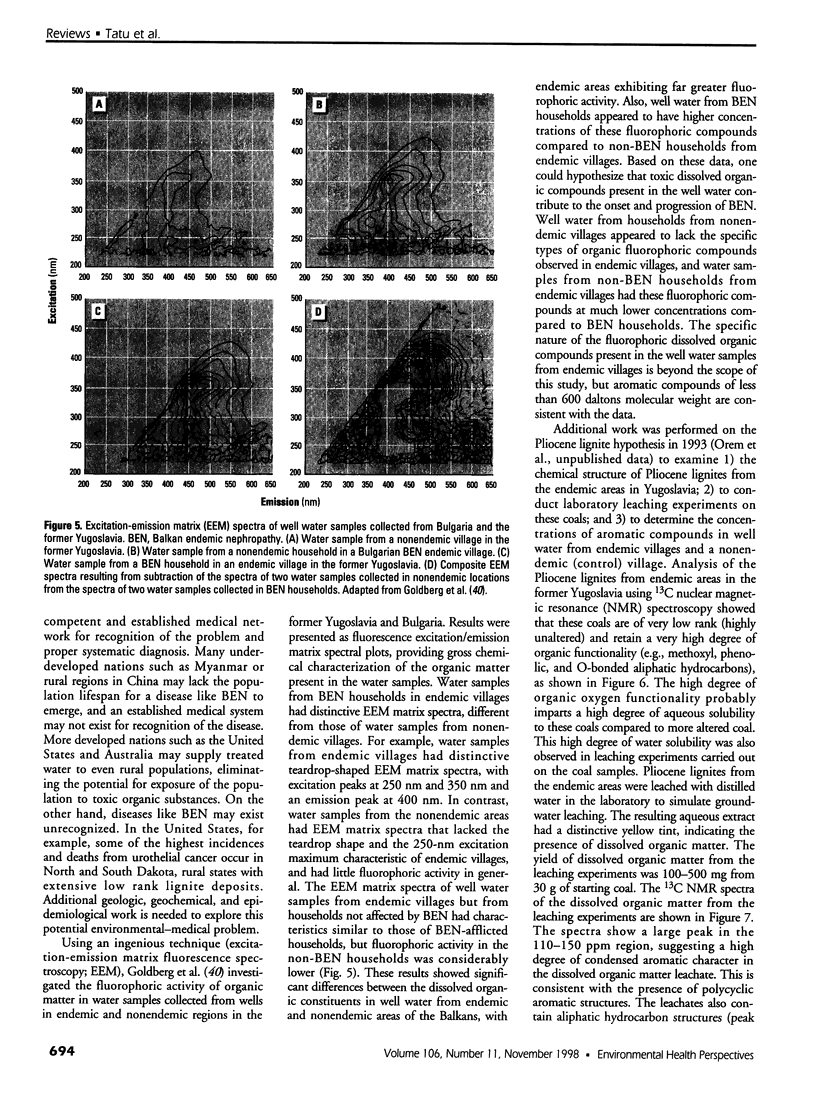
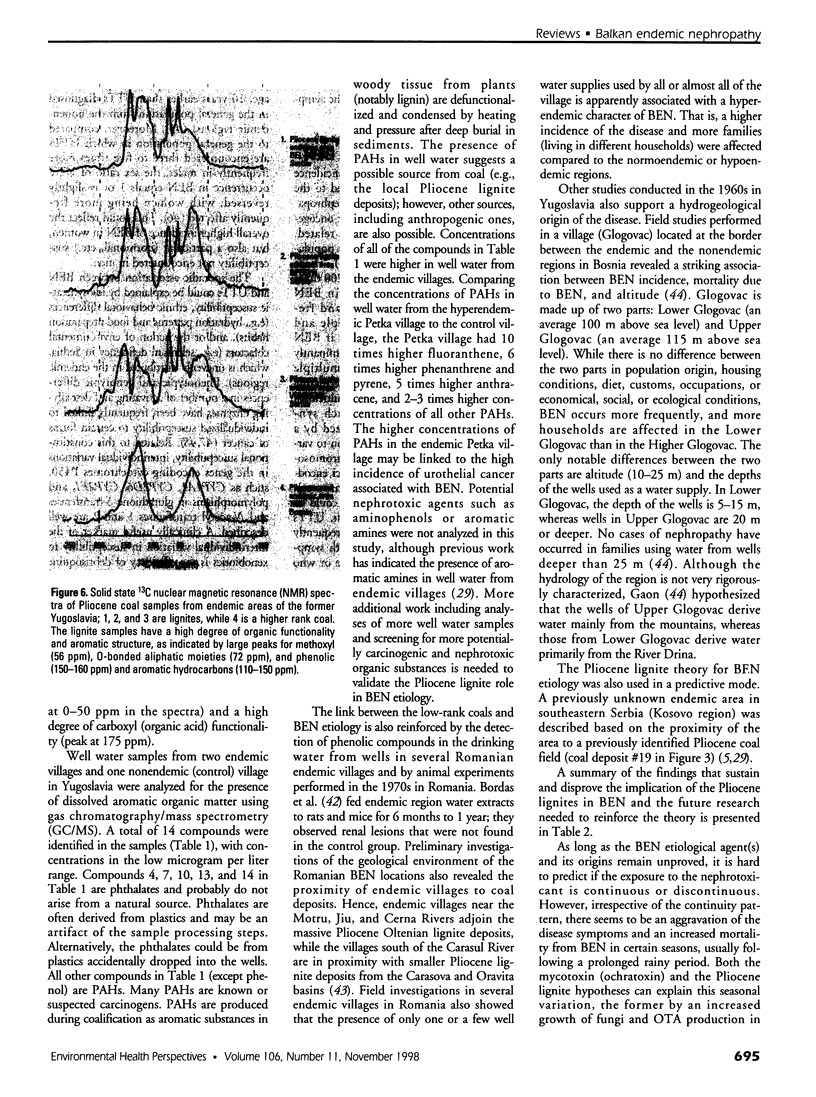
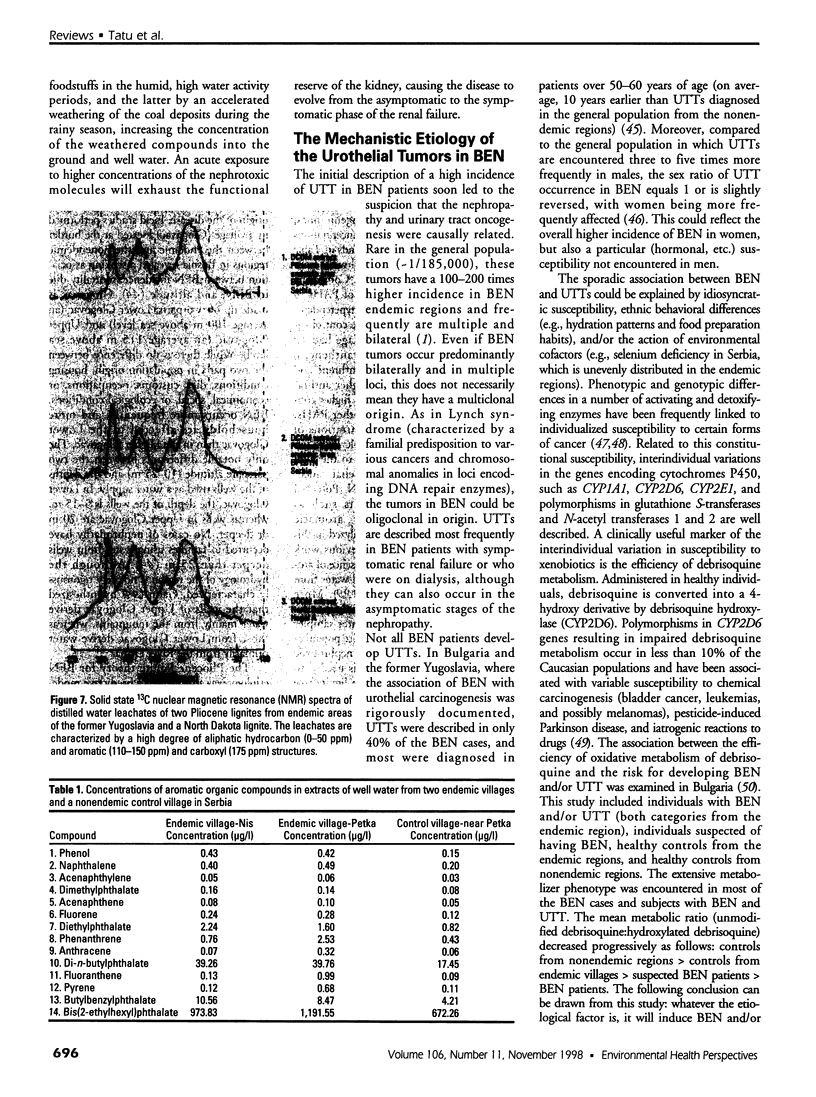
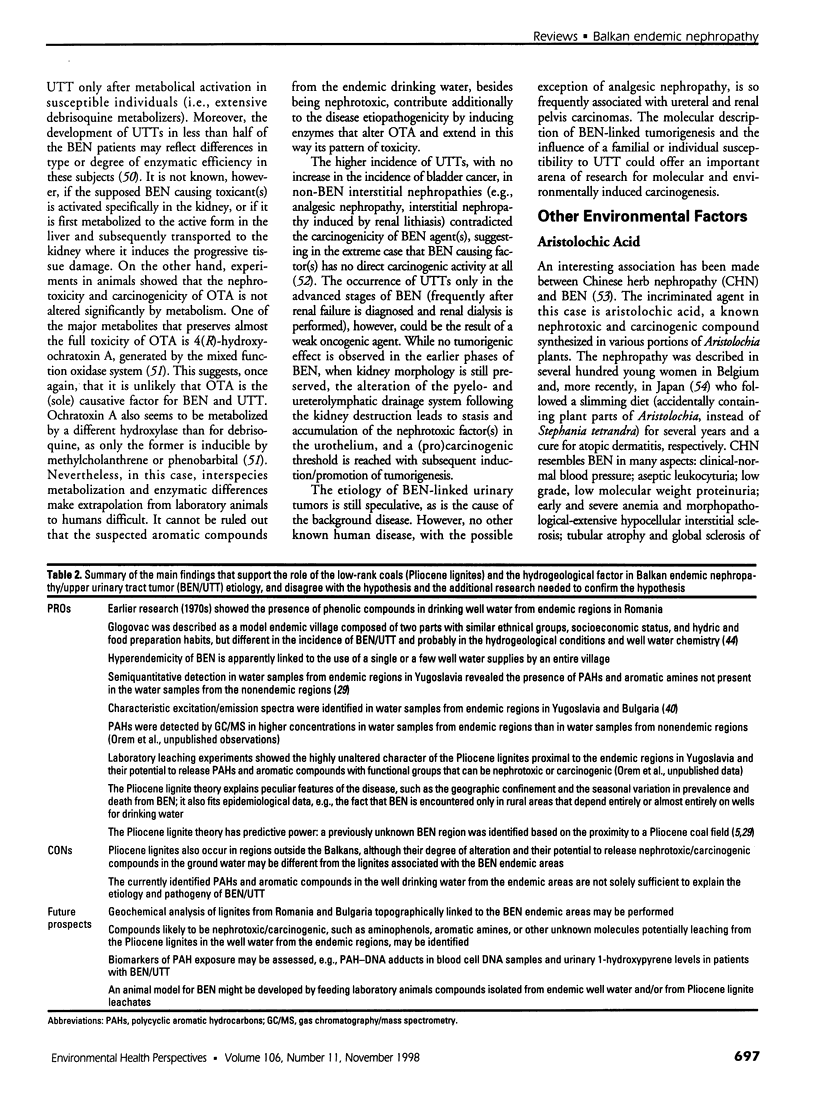
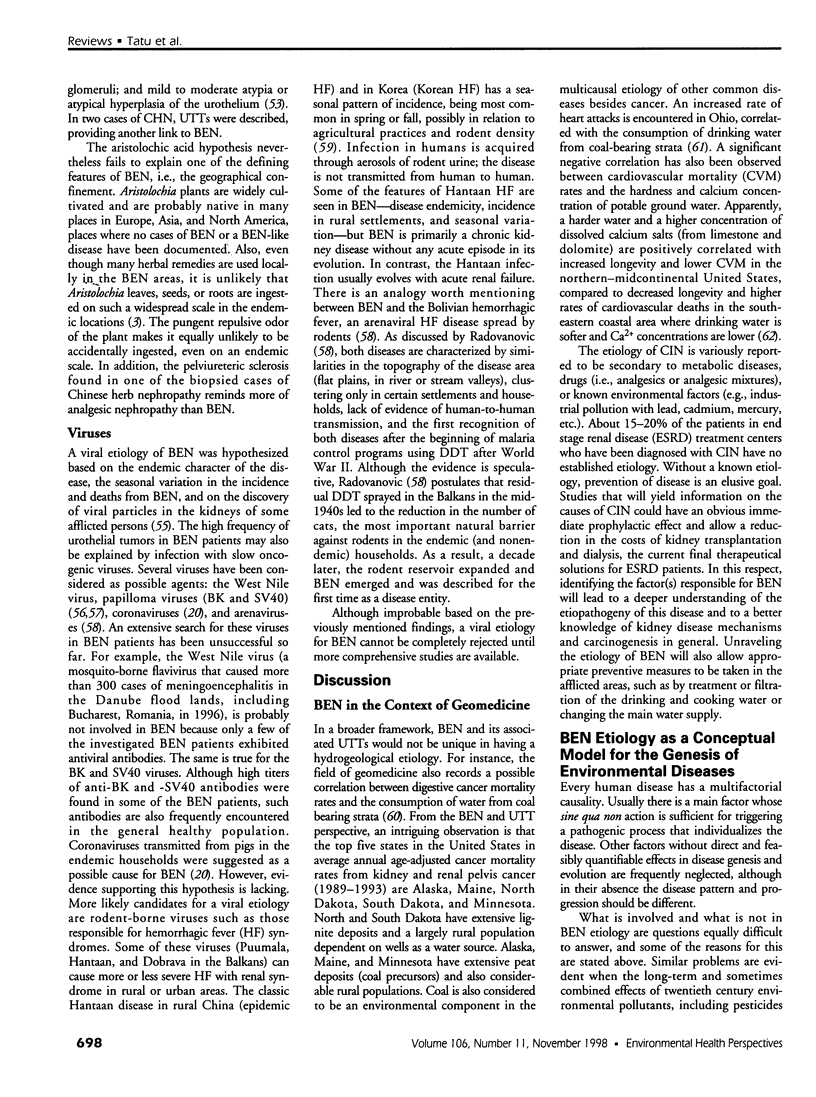
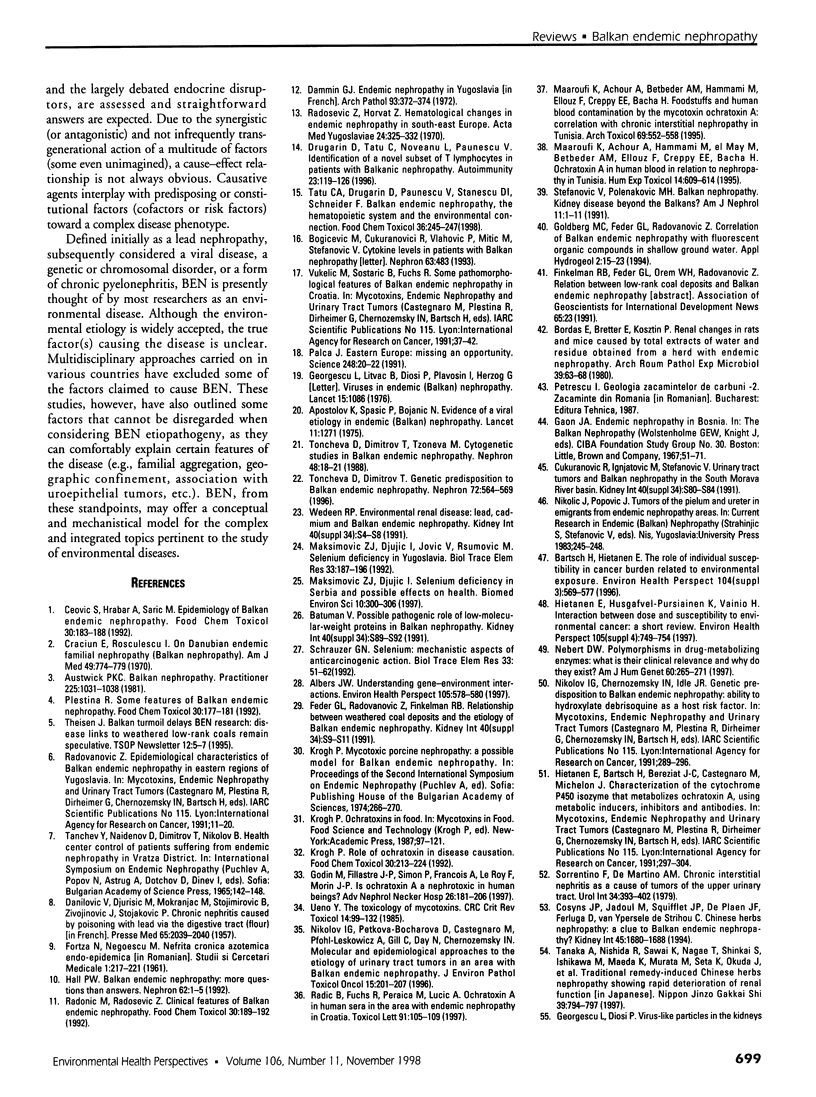
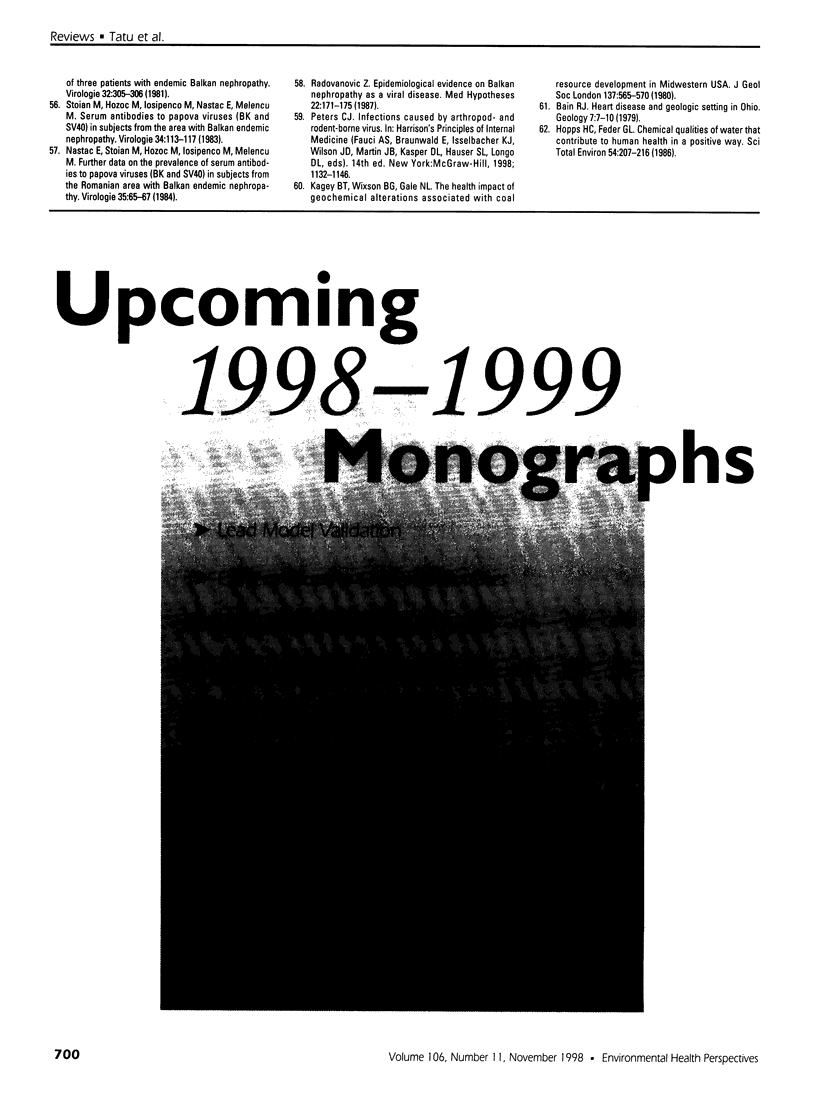
Images in this article
Selected References
These references are in PubMed. This may not be the complete list of references from this article.
- Albers J. W. Understanding gene-environment interactions. Environ Health Perspect. 1997 Jun;105(6):578–580. doi: 10.1289/ehp.97105578. [DOI] [PMC free article] [PubMed] [Google Scholar]
- Apostolov K., Spasic P. Evidence of a viral aetiology in endemic (Balkan) nephropathy. Lancet. 1975 Dec 27;2(7948):1271–1273. doi: 10.1016/S0140-6736(75)90609-1. [DOI] [PMC free article] [PubMed] [Google Scholar]
- Austwick P. K. Balkan nephropathy. Practitioner. 1981 Jul;225(1357):1031–1038. [PubMed] [Google Scholar]
- Bartsch H., Hietanen E. The role of individual susceptibility in cancer burden related to environmental exposure. Environ Health Perspect. 1996 May;104 (Suppl 3):569–577. doi: 10.1289/ehp.96104s3569. [DOI] [PMC free article] [PubMed] [Google Scholar]
- Batuman V. Possible pathogenetic role of low-molecular-weight proteins in Balkan nephropathy. Kidney Int Suppl. 1991 Nov;34:S89–S92. [PubMed] [Google Scholar]
- Bogićević M., Cukuranović R., Vlahović P., Mitić M., Stefanović V. Cytokine levels in patients with Balkan nephropathy. Nephron. 1993;63(4):483–483. doi: 10.1159/000187267. [DOI] [PubMed] [Google Scholar]
- Bordás E., Bretter E., Kosztin P. Nierenveränderungen bei ratten und mäusen unter der wirkung des totalextraktes (te), der aus dem wasser und dem totalrückstand des wassers eines herdes mit endemischer nephropathie gewonnen wurde. Arch Roum Pathol Exp Microbiol. 1980 Jan-Mar;39(1):63–68. [PubMed] [Google Scholar]
- Ceović S., Hrabar A., Sarić M. Epidemiology of Balkan endemic nephropathy. Food Chem Toxicol. 1992 Mar;30(3):183–188. doi: 10.1016/0278-6915(92)90031-f. [DOI] [PubMed] [Google Scholar]
- Cosyns J. P., Jadoul M., Squifflet J. P., De Plaen J. F., Ferluga D., van Ypersele de Strihou C. Chinese herbs nephropathy: a clue to Balkan endemic nephropathy? Kidney Int. 1994 Jun;45(6):1680–1688. doi: 10.1038/ki.1994.220. [DOI] [PubMed] [Google Scholar]
- Craciun E. C., Rosculescu I. On Danubian endemic familial nephropathy (Balkan nephropathy). Some problems. Am J Med. 1970 Dec;49(6):774–779. doi: 10.1016/s0002-9343(70)80058-4. [DOI] [PubMed] [Google Scholar]
- Cukuranović R., Ignjatović M., Stefanović V. Urinary tract tumors and Balkan nephropathy in the South Morava River basin. Kidney Int Suppl. 1991 Nov;34:S80–S84. [PubMed] [Google Scholar]
- DANILOVIC V., DJURISIC M., MOKRANJAC M., STOJIMIROVIC B., ZIVOJINOVIC J., STOJAKOVIC P. Nephrites chroniques provoquées par l'intoxication au plomb par voie digestive (farine). Presse Med. 1957 Dec 11;65(90):2039–2040. [PubMed] [Google Scholar]
- Dammin G. J. Endemic nephropathy in Yugoslavia. Arch Pathol. 1972 Apr;93(4):372–374. [PubMed] [Google Scholar]
- Drugarin D., Tatu C., Noveanu L., Paunescu V. Identification of a novel subset of T lymphocytes in patients with Balkanic nephropathy. Autoimmunity. 1996;23(2):119–126. doi: 10.3109/08916939608995335. [DOI] [PubMed] [Google Scholar]
- Feder G. L., Radovanović Z., Finkelman R. B. Relationship between weathered coal deposits and the etiology of Balkan endemic nephropathy. Kidney Int Suppl. 1991 Nov;34:S9–11. [PubMed] [Google Scholar]
- Georgescu L., Litvac B., Diosi P., Plavosin L., Herzog G. Letter: Viruses in endemic (Balkan) nephropathy. Lancet. 1976 May 15;1(7968):1086–1086. doi: 10.1016/S0140-6736(76)92274-1. [DOI] [PMC free article] [PubMed] [Google Scholar]
- Godin M., Fillastre J. P., Simon P., Francois A., Roy F. L., Morin J. P. Is ochratoxin a nephrotoxic in human beings? Adv Nephrol Necker Hosp. 1997;26:181–206. [PubMed] [Google Scholar]
- Hall P. W., 3rd Balkan endemic nephropathy: more questions than answers. Nephron. 1992;62(1):1–5. doi: 10.1159/000186985. [DOI] [PubMed] [Google Scholar]
- Hietanen E., Husgafvel-Pursiainen K., Vainio H. Interaction between dose and susceptibility to environmental cancer: a short review. Environ Health Perspect. 1997 Jun;105 (Suppl 4):749–754. doi: 10.1289/ehp.97105s4749. [DOI] [PMC free article] [PubMed] [Google Scholar]
- Hopps H. C., Feder G. L. Chemical qualities of water that contribute to human health in a positive way. Sci Total Environ. 1986 Oct;54:207–216. doi: 10.1016/0048-9697(86)90266-4. [DOI] [PubMed] [Google Scholar]
- Krogh P. Role of ochratoxin in disease causation. Food Chem Toxicol. 1992 Mar;30(3):213–224. doi: 10.1016/0278-6915(92)90036-k. [DOI] [PubMed] [Google Scholar]
- Maaroufi K., Achour A., Betbeder A. M., Hammami M., Ellouz F., Creppy E. E., Bacha H. Foodstuffs and human blood contamination by the mycotoxin ochratoxin A: correlation with chronic interstitial nephropathy in Tunisia. Arch Toxicol. 1995;69(8):552–558. doi: 10.1007/s002040050211. [DOI] [PubMed] [Google Scholar]
- Maaroufi K., Achour A., Hammami M., el May M., Betbeder A. M., Ellouz F., Creppy E. E., Bacha H. Ochratoxin A in human blood in relation to nephropathy in Tunisia. Hum Exp Toxicol. 1995 Jul;14(7):609–614. doi: 10.1177/096032719501400710. [DOI] [PubMed] [Google Scholar]
- Maksimović Z. J., Djujić I., Jović V., Rsumović M. Selenium deficiency in Yugoslavia. Biol Trace Elem Res. 1992 Apr-Jun;33:187–196. doi: 10.1007/BF02784022. [DOI] [PubMed] [Google Scholar]
- Maksimović Z. J., Djujić I. Selenium deficiency in Serbia and possible effects on health. Biomed Environ Sci. 1997 Sep;10(2-3):300–306. [PubMed] [Google Scholar]
- Nastac E., Stoian M., Hozoc M., Iosipenco M., Melencu M. Further data on the prevalence of serum antibodies to papova viruses (BK and SV40) in subjects from the Romanian area with Balkan endemic nephropathy. Virologie. 1984 Jan-Mar;35(1):65–67. [PubMed] [Google Scholar]
- Nebert D. W. Polymorphisms in drug-metabolizing enzymes: what is their clinical relevance and why do they exist? Am J Hum Genet. 1997 Feb;60(2):265–271. [PMC free article] [PubMed] [Google Scholar]
- Nikolov I. G., Petkova-Bocharova D., Castegnaro M., Pfohl-Leskowicz A., Gill C., Day N., Chernozemsky I. N. Molecular and epidemiological approaches to the etiology of urinary tract tumors in an area with Balkan endemic nephropathy. J Environ Pathol Toxicol Oncol. 1996;15(2-4):201–207. [PubMed] [Google Scholar]
- Palca J. Eastern Europe: missing an opportunity. Science. 1990 Apr 6;248(4951):20–22. doi: 10.1126/science.2321022. [DOI] [PubMed] [Google Scholar]
- Plestina R. Some features of Balkan endemic nephropathy. Food Chem Toxicol. 1992 Mar;30(3):177–181. doi: 10.1016/0278-6915(92)90030-o. [DOI] [PubMed] [Google Scholar]
- Radić B., Fuchs R., Peraica M., Lucić A. Ochratoxin A in human sera in the area with endemic nephropathy in Croatia. Toxicol Lett. 1997 Apr 28;91(2):105–109. doi: 10.1016/s0378-4274(97)03877-0. [DOI] [PubMed] [Google Scholar]
- Radonić M., Radosević Z. Clinical features of Balkan endemic nephropathy. Food Chem Toxicol. 1992 Mar;30(3):189–192. doi: 10.1016/0278-6915(92)90032-g. [DOI] [PubMed] [Google Scholar]
- Radovanović Z. Epidemiological evidence on Balkan nephropathy as a viral disease. Med Hypotheses. 1987 Feb;22(2):171–175. doi: 10.1016/0306-9877(87)90140-X. [DOI] [PMC free article] [PubMed] [Google Scholar]
- Schrauzer G. N. Selenium. Mechanistic aspects of anticarcinogenic action. Biol Trace Elem Res. 1992 Apr-Jun;33:51–62. doi: 10.1007/BF02783992. [DOI] [PubMed] [Google Scholar]
- Sorrentino F., de Martino A. M. Chronic interstitial nephritis as a cause of tumours of the upper urinary tract. A hypothesis. Urol Int. 1979;34(6):393–402. doi: 10.1159/000280286. [DOI] [PubMed] [Google Scholar]
- Stefanović V., Polenaković M. H. Balkan nephropathy. Kidney disease beyond the Balkans? Am J Nephrol. 1991;11(1):1–11. doi: 10.1159/000168264. [DOI] [PubMed] [Google Scholar]
- Stoian M., Hozoc M., Iosipenco M., Nastac E., Melencu M. Serum antibodies to papova viruses (BK and SV 40) in subjects from the area with Balkan endemic nephropathy. Virologie. 1983 Apr-Jun;34(2):113–117. [PubMed] [Google Scholar]
- Tanaka A., Nishida R., Sawai K., Nagae T., Shinkai S., Ishikawa M., Maeda K., Murata M., Seta K., Okuda J. [Traditional remedy-induced Chinese herbs nephropathy showing rapid deterioration of renal function]. Nihon Jinzo Gakkai Shi. 1997 Dec;39(8):794–797. [PubMed] [Google Scholar]
- Tatu C. A., Drugarin D., Paunescu V., Stanescu D. I., Schneider F. Balkan endemic nephropathy, the haematopoietic system and the environmental connection. Food Chem Toxicol. 1998 Mar;36(3):245–247. doi: 10.1016/s0278-6915(97)00137-3. [DOI] [PubMed] [Google Scholar]
- Toncheva D., Dimitrov T. Genetic predisposition to Balkan endemic nephropathy. Nephron. 1996;72(4):564–569. doi: 10.1159/000188940. [DOI] [PubMed] [Google Scholar]
- Toncheva D., Dimitrov T., Tzoneva M. Cytogenetic studies in Balkan endemic nephropathy. Nephron. 1988;48(1):18–21. doi: 10.1159/000184862. [DOI] [PubMed] [Google Scholar]
- Ueno Y. The toxicology of mycotoxins. Crit Rev Toxicol. 1985;14(2):99–132. doi: 10.3109/10408448509089851. [DOI] [PubMed] [Google Scholar]
- Wedeen R. P. Environmental renal disease: lead, cadmium and Balkan endemic nephropathy. Kidney Int Suppl. 1991 Nov;34:S4–S8. [PubMed] [Google Scholar]



